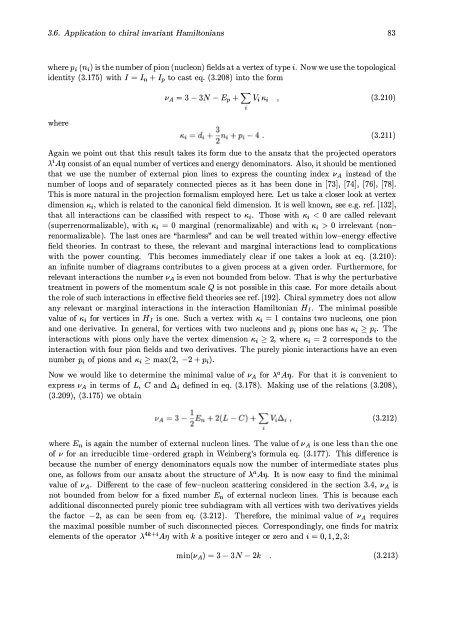The Nucleon-Nucleon Interaction in a Chiral Effective Field Theory
The Nucleon-Nucleon Interaction in a Chiral Effective Field Theory
The Nucleon-Nucleon Interaction in a Chiral Effective Field Theory
Create successful ePaper yourself
Turn your PDF publications into a flip-book with our unique Google optimized e-Paper software.
3.6. Application to chiral <strong>in</strong>variant Hamiltonians 83<br />
where Pi (ni) is the number ofpion (nucleon) fields at a vertex oftype i. Now we use the topological<br />
identity (3.175) with I = In + Ip to cast eq. (3.208) <strong>in</strong>to the form<br />
vA = 3 -3N - Ep + L l'i /'\,i (3.210)<br />
where<br />
(3.211)<br />
Aga<strong>in</strong> we po<strong>in</strong>t out that this result takes its form due to the ansatz that the projected operators<br />
)..i A17 consist of an equal number of vertices and energy denom<strong>in</strong>ators. Also, it should be mentioned<br />
that we use the number of external pion l<strong>in</strong>es to express the count<strong>in</strong>g <strong>in</strong>dex VA <strong>in</strong>stead of the<br />
number of loops and of separately connected pieces as it has been done <strong>in</strong> [73], [74], [76], [78].<br />
This is more natural <strong>in</strong> the projection formalism employed here. Let us take a doser look at vertex<br />
dimension /'\,i, which is related to the canonical field dimension. It is weIl known, see e.g. ref. [132],<br />
that all <strong>in</strong>teractions can be classified with respect to /'\,i. Those with /'\,i < 0 are called relevant<br />
(superrenormalizable), with /'\,i = 0 marg<strong>in</strong>al (renormalizable) and with /'\,i > 0 irrelevant (non<br />
renormalizable). <strong>The</strong> last ones are "harmless" and can be wen treated with<strong>in</strong> low-energy effective<br />
field theories. In contrast to these, the relevant and marg<strong>in</strong>al <strong>in</strong>teractions lead to complications<br />
with the power count<strong>in</strong>g. This becomes immediately clear if one takes a look at eq. (3.210):<br />
an <strong>in</strong>f<strong>in</strong>ite number of diagrams contributes to a given process at a given order. Furthermore, for<br />
relevant <strong>in</strong>teractions the number VA is even not bounded from below. That is why the perturbative<br />
treatment <strong>in</strong> powers of the moment um scale Q is not possible <strong>in</strong> this case. For more details about<br />
the role of such <strong>in</strong>teractions <strong>in</strong> effective field theories see ref. [192]. <strong>Chiral</strong> symmetry does not allow<br />
any relevant or marg<strong>in</strong>al <strong>in</strong>teractions <strong>in</strong> the <strong>in</strong>teraction Hamiltonian Hf. <strong>The</strong> m<strong>in</strong>imal possible<br />
value of /'\,i for vertices <strong>in</strong> Hf is one. Such a vertex with /'\,i = 1 conta<strong>in</strong>s two nucleons, one pion<br />
and one derivative. In general, for vertices with two nucleons and Pi pions one has /'\,i 2 Pi. <strong>The</strong><br />
<strong>in</strong>teractions with pions only have the vertex dimension /'\,i 2 2, where /'\,i = 2 corresponds to the<br />
<strong>in</strong>teraction with four pion fields and two derivatives. <strong>The</strong> purely pionic <strong>in</strong>teractions have an even<br />
number Pi of pions and /'\,i 2 max(2, -2 + Pi).<br />
Now we would like to determ<strong>in</strong>e the m<strong>in</strong>imal value of VA for )..a A17. For that it is convenient to<br />
express vA <strong>in</strong> terms of L, C and ßi def<strong>in</strong>ed <strong>in</strong> eq. (3.178). Mak<strong>in</strong>g use of the relations (3.208),<br />
(3.209), (3.175) we obta<strong>in</strong><br />
(3.212)<br />
where En is aga<strong>in</strong> the number of external nudeon l<strong>in</strong>es. <strong>The</strong> value of VA is one less than the one<br />
of v for an irreducible time-ordered graph <strong>in</strong> We<strong>in</strong>berg's formula eq. (3.177). This difference is<br />
because the number of energy denom<strong>in</strong>ators equals now the number of <strong>in</strong>termediate states plus<br />
one, as follows from our ansatz about the structure of )..a A17. It is now easy to f<strong>in</strong>d the m<strong>in</strong>imal<br />
value of VA. Different to the case of few-nudeon scatter<strong>in</strong>g considered <strong>in</strong> the section 3.4, VA is<br />
not bounded from below for a fixed number En of external nudeon l<strong>in</strong>es. This is because each<br />
additional disconnected purely pionic tree subdiagram with all vertices with two derivatives yields<br />
the factor -2, as can be seen from eq. (3.212). <strong>The</strong>refore, the m<strong>in</strong>imal value of VA requires<br />
m<strong>in</strong>(VA) = 3 -3N -2k (3.213)<br />
the maximal possible number of such disconnected pieces. Correspond<strong>in</strong>gly, one f<strong>in</strong>ds for matrix<br />
elements of the operator )..4k+i AT] with k a positive <strong>in</strong>teger or zero and i = 0,1,2,3:












